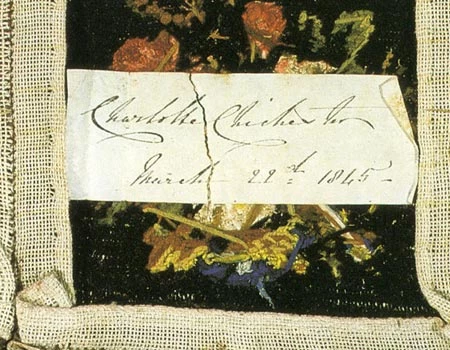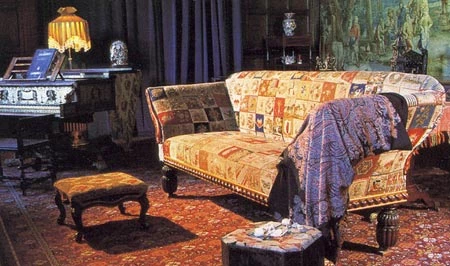The Edwinsford Sofa - spectacular embroidery spends a month in deep freeze
In 1998 Amgueddfa Cymru purchased furniture from the Edwinsford estate, near Talley, Llandeilo. The largest and most spectacular piece is a unique embroidered sofa from 1845. Conserving this proved to be a fascinating and challenging project, included dismantling, rebuilding and even freezing the object for a month.
The sofa contains several individually embroidered squares of wool and silk decorated with metal threads and beads, illustrating original Berlin wool-work designs. The squares form four separate panels along with carved wooden mouldings around the lower edge and carved scroll panels over the arm fronts.
Conserving the sofa
The reverse side of the back panel before removal of the labels and cleaning.
At first glace, it was clear that a lot of repair would be needed if the sofa was to be displayed, as it was dirty, worn and shabby. Many seams had ripped and a moth infestation had destroyed much of the delicate embroidery. In order for each panel of canvas-work to be conserved properly, it had to be removed from the framework.
The mouldings were removed easily. However, instead of the usual upholstered technique, the sofa was made up of four individually upholstered sections, covered in the canvas work panels, and then screwed and bolted together. Approximately 300 tacks had to be carefully removed without ripping the canvas work — although they had already made rusty holes in the fabric.
A sofa decorated by guests
One canvas square was dated on the reverse 'Charlotte Chichester March 22nd 1845'
The dismantling process uncovered a fascinating story. As the tacks were removed, paper labels started to drop out from behind the canvas work, each label bearing a someone's name. The names showed who had embroidered each square. Apparently, visitors to Edwinsford had embroidered the squares, and the sofa was designed to display this work.
After careful documentation of the labels, each canvas-work square was cleaned with washing solutions and solvents according to the dyes present. Each panel was then supported on undyed linen to strengthen the fabric and make the finished sofa more stable. Fine nylon net was applied around the frayed edges.
A month in deep freeze
In case there might be still live moth eggs in the sofa, each section was double-wrapped and sealed in polythene, and then frozen for a month.
Putting the sofa back together
Much of the upholstered furniture on display in the withdrawing room of St Fagans Castle comes originally from Edwinsford Estate, Camarthenshire.
A method of re-attaching the cleaned canvas panels had to be found. It was important not to staple directly through the canvas-work, and to limit the number of staples put into the already damaged wooden carcass. It was equally important to be able to remove the panels without damage, should this be necessary in the future.
To achieve this, cotton tape was stapled to the wooden frames along the original tack hole lines. Staples were positioned approximately every 15cm to provide a rigid base to which the panels could be sewn using a curved needle. The inner edges of the arms and back had to be stitched first and then screwed and bolted back in position. The outer edges could then be stitched in place.
After treatment, the remaining sections of the sofa were replaced, using the original screws and nails wherever possible. Treatment of the paper labels will allow future study and display.
The sofa is on display in St Fagans Castle.


